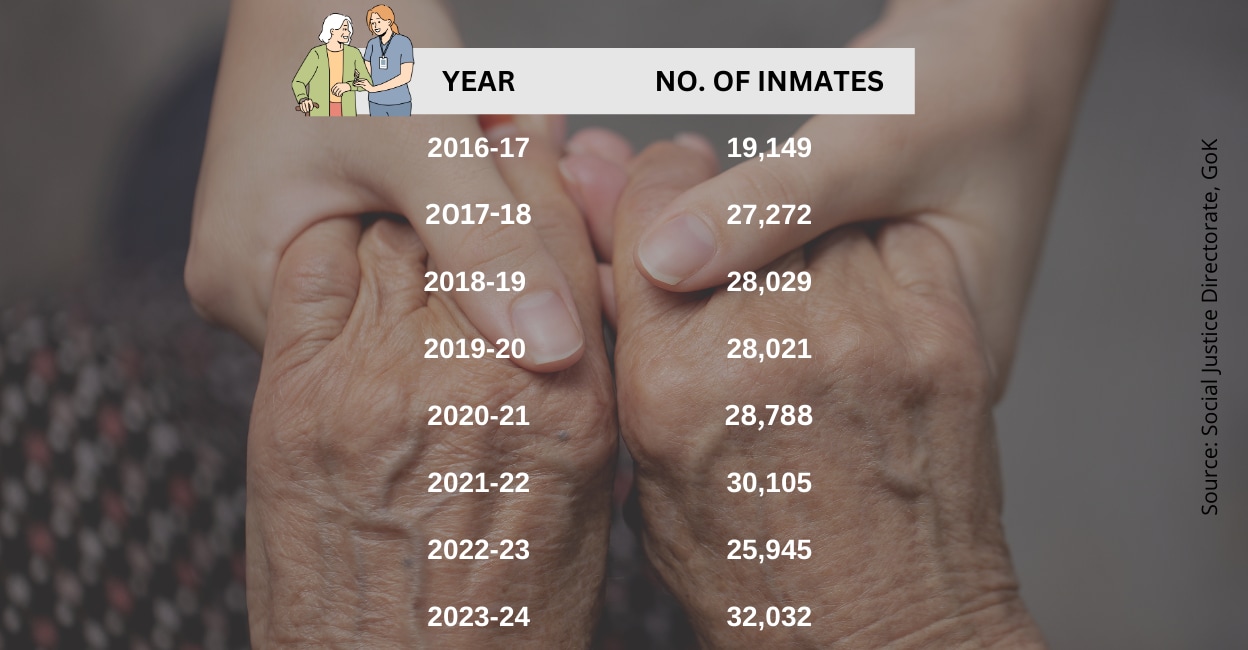Care home occupancy in fast-ageing Kerala swells by 67% in a decade

Mail This Article
Kerala ages faster than anywhere else in the country, studies show, and the effect is felt in old-age homes in the state. In less than a decade, the occupancy in care homes rose by 67.27 per cent in Kerala, according to data from the Directorate of Social Justice. The number of inmates in care homes increased from 19,149 in 2016-17 to 32,032 in 2023-24. These figures were furnished in the Economic Review-2024, which analysed the changing demographic profile of the state.
Officials with the Social Justice Department attribute this spike to various socio-economic factors. Many elderly parents are abandoned by their children, citing financial or personal constraints to take care of them. Meanwhile, some seniors, particularly unmarried or childless, voluntarily opt for shelters when they become incapable of managing their daily lives. Notably, government care homes predominantly house those from financially deprived backgrounds.
Radhika K, Superintendent of the Government Old Age Home in Thrissur, notes that most residents come from lower-middle-class families. Surprisingly, we also see people from well-settled families whose kids are financially capable but still abandon them here to avoid the responsibilities and expenses of private centres," she says. There are even cases where kids send their parents to care homes after being neglected by them as children.
Isha Beevi KM, Superintendent of the Old Age Home in Alappuzha, highlights another troubling trend. "Migration of the younger generation abroad for studies and work is one cause. In some cases, addiction issues among the youths lead to neglect, forcing the elderly to seek shelter in care homes. People's mindsets towards elder care are also shifting," she adds.
The Kerala Budget 2024-25 points out that nearly 20 per cent of Kerala's population will be above 60 years in the near future, making elderly care a pressing issue. It also highlights the grim reality that many elderly citizens live alone, without family support. Dipping birth rates and rising life expectancy have turned Kerala into an ageing state, with a majority of the population over 60.
Kerala has also recorded a spike in old-age dependency ratio (OADR); the number of persons aged 65 years and over, per 100 persons of working age (20 to 64 years), which is the most commonly used indicator for monitoring changes in the age structure of the population. According to the ER, the ratio has increased from 14.2 per cent in 2011 to 15.7 per cent in 2021 and is projected to be 20.1 per cent in 2031 at the all-India level. OADR of Kerala was 19.6 per cent as per the 2011 Census and is projected to be 26.1 per cent in 2021 and 34.3 per cent in 2031.

Currently, Kerala has 16 government-run old age homes, including dementia care centres and facilities for persons with disabilities, managed by the Social Justice Department. Additionally, around 680 old-age homes are registered under the Orphanage Control Board. Interestingly, many elderly people prefer staying in care homes, enjoying companionship and structured activities, despite having the chance to return to their families.
Local body officials occasionally intervene when elderly individuals are found in dire conditions, having no one to look after them. "In some cases, even couples who can no longer work turn themselves in or are rescued and brought to us," says Isha Beevi. However, troubling patterns persist. Some children temporarily take their parents home to gain control of family properties, only to send them back afterwards. “Often, they claim they’re building a new house and will take these people in once it's ready. But that rarely happens,” Isha Beevi observes.
Sebastian Augustin, Superintendent of the Government Old Age Home in Kottayam, points out that parents with only daughters often end up in care homes after their children marry and move in with their spouses. "In some cases, when the young ones start working, they feel compelled to send the elderly to care homes," he adds. Relatives may also briefly take the inmates home for family functions before returning them.
Perhaps the most heartbreaking aspect is when families refuse to claim the bodies of deceased residents. In such cases, the old age homes handle the cremation after completing the necessary formalities. “Most of these situations arise in nuclear families where parents are considered burdens. It ultimately boils down to selfishness,” Radhika K says.


